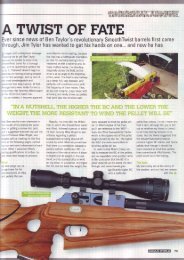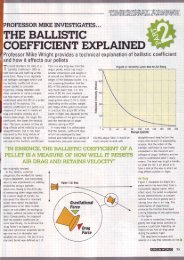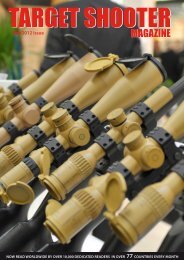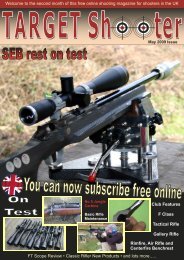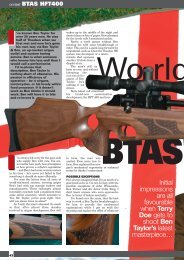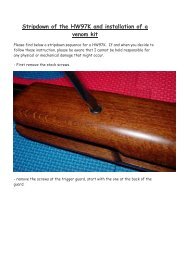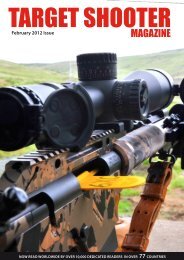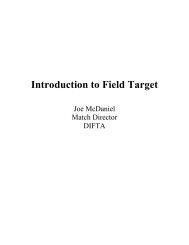Target Shooter 1
Target Shooter 1
Target Shooter 1
Create successful ePaper yourself
Turn your PDF publications into a flip-book with our unique Google optimized e-Paper software.
wind.<br />
Running this simulation<br />
multiple times can reveal<br />
how much difference a<br />
certain performance<br />
advantage can make to a<br />
shooter’s score.<br />
The model assumes our<br />
hypothetical shooter is<br />
able to hold X-ring (V-<br />
Bull in British shooting<br />
terminology) elevation,<br />
and in order to generate<br />
equal conditions for the<br />
various bullets, it applies<br />
a crosswind uncertainty<br />
of +/- 2 mph.<br />
(Specifically, the standard<br />
deviation of the shooters/<br />
coach’s ability to call wind<br />
is 1 mph.) In other words,<br />
the crosswind uncertainty<br />
is modelled to be less than<br />
2 mph for 19/20 shots.<br />
Figure 4 how do you model<br />
a shooter, and the<br />
effects of bullet<br />
performance on score? The way I’ve<br />
chosen to approach this is statistically. A ballistics<br />
program was looped to run for 20 shots. On each<br />
shot a different wind uncertainty is applied to<br />
represent the effect of an imperfect wind judgment<br />
by the shooter or coach. The idea is that the better<br />
performing bullets should result in fewer lost<br />
points because they’re deflected less by a given<br />
Figure 4 shows a visual<br />
representation of a<br />
‘virtual group’ produced<br />
by the computer model<br />
using the aforementioned<br />
conditions<br />
and<br />
uncertainties. The table<br />
underneath provides the<br />
numeric values for the<br />
series of runs of the<br />
model, that is 100<br />
simulated 20-shot 1,000<br />
yard matches using the<br />
American NRA ‘Fullbore’<br />
target. It shows<br />
the minimum and<br />
maximum simulated<br />
scores (in individual<br />
‘matches’), plus the average score for the entire<br />
series for each of the eight bullets.<br />
Some apparently strange features of the<br />
results are related to the statistical nature of the<br />
simulation. For example, notice that the highest<br />
individual ‘match score’ with the new Sierra and<br />
the Berger VLD is one point higher than those<br />
for the three higher BC bullets at the top of the<br />
list. This shows that over the course of 100<br />
matches, it’s possible to shoot a higher score with a<br />
62 <strong>Target</strong> <strong>Shooter</strong>



